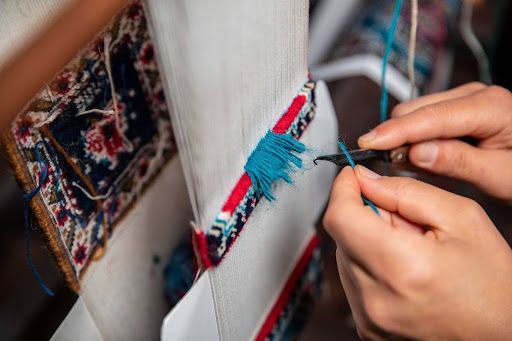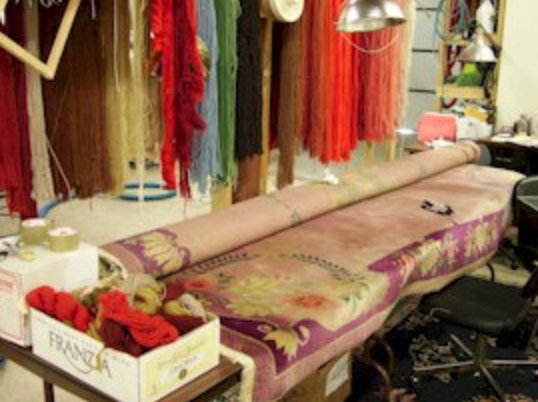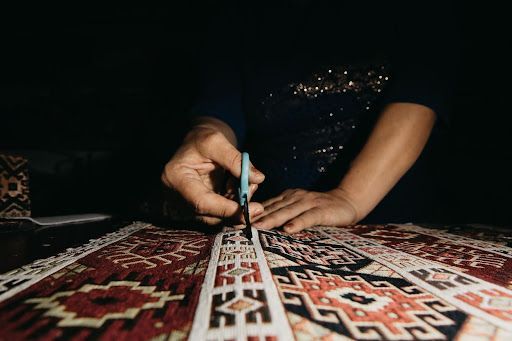Oriental Rug Cleaning
We keep our work tables full throughout the cold winter months by offering 20% off on most Rug Restoration that is performed in January of each year.
Business Info:
Ijamsville, MD 21754
Frederick City Drop-Off Location Hours: Mon-Fri 7-7; Sat 8-6
Gaithersburg MD 20877
Frederick County 301-831-3594
Bethesda & DC 301-493-8181
Carroll County 301-831-3594
Toll Free 800-804-3681
Free Pickup & Delivery!
Oriental Rug Repair in Ijamsville MD: What You Need to Know
Got a Damaged Oriental Rug That's Breaking Your Heart? We get it. You're staring at that gorgeous Persian rug your grandmother left you, and there's a hole right in the middle of it. Or maybe your dog had an accident on your prized Turkish rug last week. Whatever happened, you're probably feeling a mix of panic and frustration right now.
Here's the thing - I've been fixing oriental rugs in the Ijamsville area for years, and I've seen it all. That sick feeling you get when you notice damage to a rug you love? I see it on customers' faces every single day. But we also get to see the relief when they realize their rug can actually be saved.
Let me tell you what really happens to oriental rugs around here.
Living in Maryland is tough on rugs. The humidity gets them. The moths love them. Kids spill juice on them. Dogs... well, you know what dogs do.
Last month, a woman brought me a rug that had been in her family for three generations. Her cat had been sick and used it as a bathroom for weeks before she realized what was happening. She was crying when she brought it in. She thought it was ruined forever.
It wasn't. We saved it. But it took some serious work.
The truth is, most people don't understand what they're dealing with when they own an oriental rug. These aren't the rugs you buy at the big box store. They're hand-knotted pieces of art that were made to last centuries, not decades. But only if you take care of them properly.
Here's what we wish people knew before problems start.
Your oriental rug is basically a piece of woven history. Someone sat at a loom for months, maybe years, tying individual knots to create the pattern you see. They used materials that were chosen specifically for durability and beauty.
But here's what most people miss - those same qualities that make oriental rugs so special also make them tricky to repair. You can't just slap a patch on them and call it good.
we had a customer last year who tried to fix a small hole himself with some craft store yarn. By the time he brought it to me, what started as a quarter-sized problem had turned into a section the size of a dinner plate. The yarn he used was the wrong thickness, wrong color, and wrong material. Every time someone walked on it, it pulled at the surrounding fibers and made the hole bigger.
That's the kind of thing that keeps me up at night.
What actually goes wrong with these rugs?
Moths are enemy number one around here. I swear they can smell wool from three counties away. They lay their eggs in your rug, and the larvae eat holes right through the fibers. People usually don't notice until the damage is already done.
The frustrating part is that moth damage is totally preventable. Regular cleaning and proper storage when rugs aren't in use stops most moth problems before they start. But once you've got holes, you need professional help.
Water damage is another big one. Basement floods, leaky pipes, kids spilling drinks - water and oriental rugs don't mix well. The wool fibers can handle some moisture, but if water sits in the rug for too long, you're looking at foundation damage, color bleeding, and potential mold issues.
We remember one customer whose basement flooded during a heavy storm. She had five oriental rugs down there, and she didn't call me for three days because she was dealing with insurance and cleanup. By the time we saw the rugs, two of them had started growing mold. We saved them, but it took weeks of specialized treatment and cost way more than it would have if she'd called immediately.
Pet accidents happen to everyone. Don't be embarrassed about it - I've seen everything. The key is acting fast. Pet urine contains ammonia, and ammonia breaks down wool fibers permanently if it's allowed to sit. But if you call me within a day or two, we can usually fix the problem completely.
Edge damage is super common and totally normal. The binding around the edges of your rug takes the most abuse. People walk on it, vacuum cleaners bump into it, furniture legs catch it. Eventually, it starts to come apart.
Here's the thing about edge damage - it looks minor, but it's not. Once the binding fails, your rug will start unraveling from the edges inward. I've seen rugs lose inches of width because someone ignored loose binding for too long.
What really happens during a proper repair?
First, we need to figure out exactly what we are dealing with. Not all oriental rugs are created equal. A Persian rug from the 1960s needs different treatment than a Turkish rug from last year. The materials are different, the construction techniques are different, even the dyes respond differently to cleaning and repair methods.
We spend a lot of time just looking at rugs. We are checking the knot density, the type of wool, the condition of the foundation threads, the stability of the dyes. This isn't something you can rush.
Cleaning usually comes first, even before repairs. You can't properly assess damage when the rug is dirty. But cleaning oriental rugs isn't like shampooing your living room carpet. These rugs need hand washing with specific detergents that won't damage natural fibers or cause color bleeding.
The actual repair work is where things get interesting. Small holes need to be rewoven knot by knot using wool that matches the original as closely as possible. This means we keep a huge inventory of different wool colors and textures. Sometimes I have to custom-dye wool to get an exact match.
For larger damage,we might need to rebuild sections of the rug's foundation before we can even start on the surface repairs. This is invisible work that no one will ever see, but it's critical for the rug's long-term stability.
Edge work is its own art form. The binding has to be strong enough to prevent unraveling but flexible enough that it doesn't create stress points that could tear. We use traditional techniques and materials whenever possible because they've been proven to work over centuries.
Why working with someone local actually matters
We can't tell you how many rugs we have seen that were damaged during shipping to out-of-state repair facilities. Oriental rugs are heavy, and they need to be rolled and packed very carefully to avoid creasing or folding damage. When you work with someone local, your rug never leaves the area.
Plus, you can come see your rug during the repair process. We encourage customers to stop by and check on progress. It helps them understand what we're doing and why it takes time.
We also understand the specific challenges rugs face in this area. Maryland humidity, local pest issues, the types of soil that get tracked in on shoes - all of this affects how I approach cleaning and repair work.

Let's talk about money for a minute.
People always want to know if repair is worth it or if they should just buy a new rug. Here's my honest take on it.
If you've got a machine-made rug that cost a few hundred dollars, extensive repairs probably don't make financial sense. But if you're dealing with a genuine hand-knotted oriental rug, especially one with personal or family history, repair is almost always worth it.
Good oriental rugs have actually gotten more expensive over the years, not less. What your parents or grandparents paid for their rugs is probably a fraction of what you'd pay for something comparable today. From a purely financial standpoint, preservation makes sense.
But money isn't the only factor. If the rug has sentimental value, that weighs heavily in favor of repair. We have worked on rugs that weren't worth much financially but meant everything to the families who owned them.
We always give people honest estimates and explain exactly what the repair will involve. If we don't think a repair is worth the cost, we'll tell you that upfront. My reputation depends on giving good advice, not just taking every job that walks through the door.
Here's what we really want you to know.
Your oriental rug represents incredible craftsmanship. The person who made it spent months creating something meant to last generations. When damage happens, it's not the end of the world. Most problems can be fixed if you get professional help soon enough.
We've been doing this work for years because we love bringing these rugs back to life. Every rug tells a story, and my job is to make sure that story continues.
If you're in the Ijamsville area and you're dealing with rug damage, don't panic. But also don't wait. Rug damage almost always gets worse over time, never better. Early intervention saves you money and gives you better results.
Call me. Let me take a look at what you're dealing with. we'll give you an honest assessment of what can be done and what it will cost. No pressure, no sales pitch - just straight talk about your options.
Your rug has survived this long. With proper care, it can survive a lot longer.
Common questions I get asked every day
1. How long will it take?
Depends entirely on what needs to be done. Simple cleaning and edge binding might take a week. Complex reweaving can take months. We know that's frustrating, but quality work takes time. I'd rather give you a realistic timeline than promise something I can't deliver.
2. Will we be able to see where it was repaired?
Good repairs should be nearly invisible. You might know where the work was done, but visitors shouldn't be able to spot it easily. If a repair is going to be obvious, We'll explain that before we start.
3. Can you fix any oriental rug?
Most of them, yes. Very severe damage might not be economically feasible to repair completely, but even heavily damaged rugs can usually be stabilized to prevent further deterioration.
4. Should we try to clean spots ourselves?
Please don't. We see so many rugs that were damaged by well-meaning owners trying to clean stains with household products. What starts as a small spot often becomes a big blotch with color bleeding or fiber damage.
5. How can we prevent problems?
Regular professional cleaning helps tremendously. Rotate your rugs periodically so they wear evenly. Use quality rug pads to protect the foundation. Address problems quickly before they get worse - it's always cheaper than waiting.


